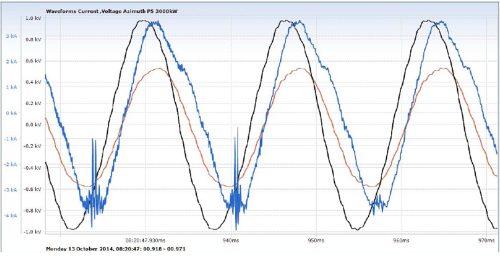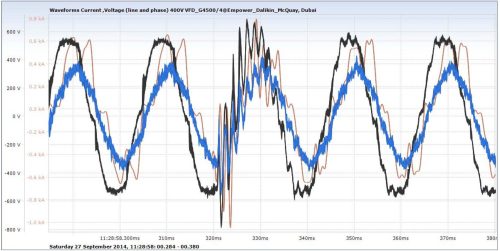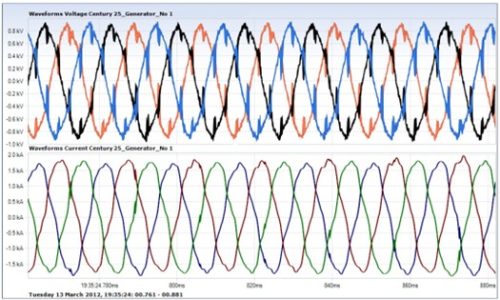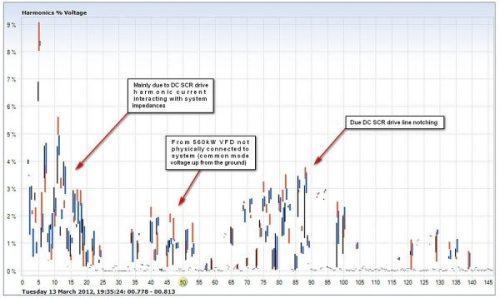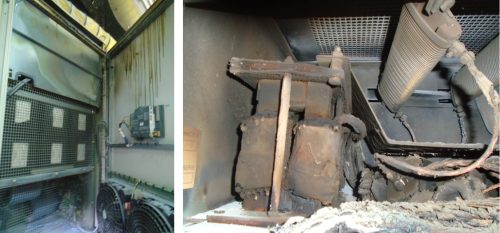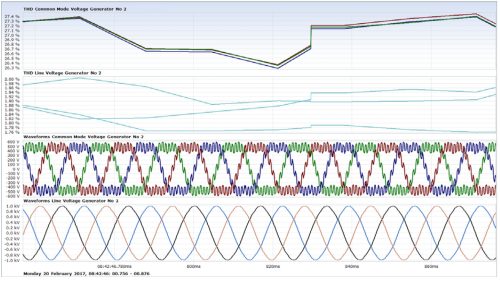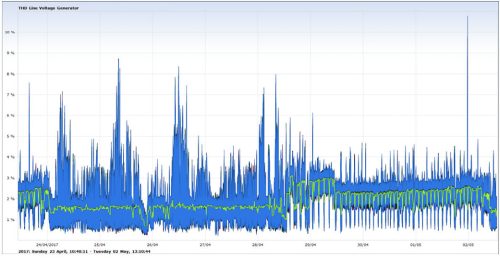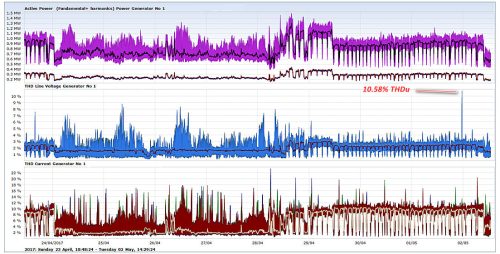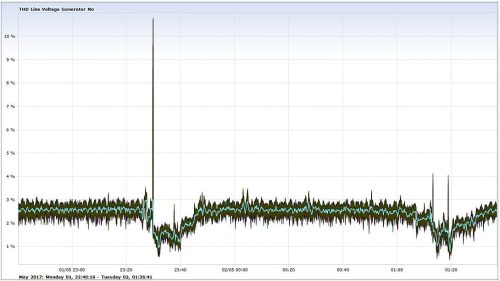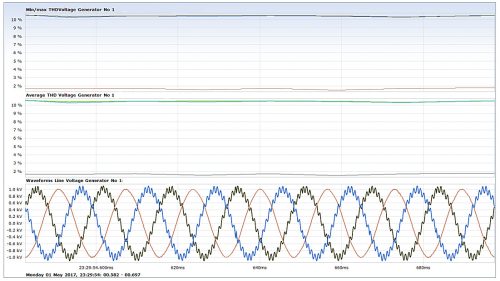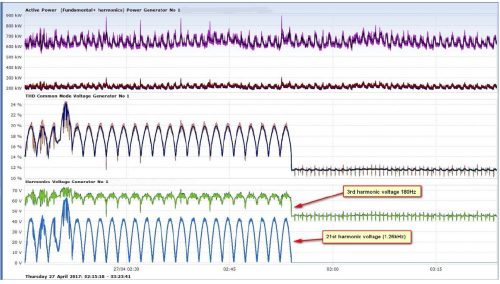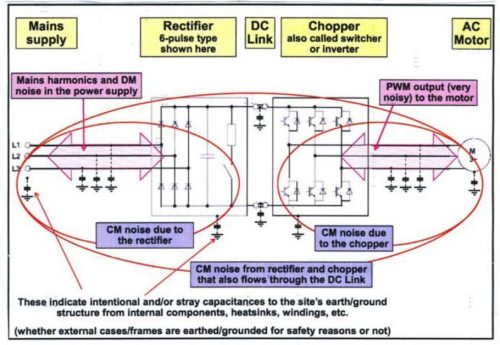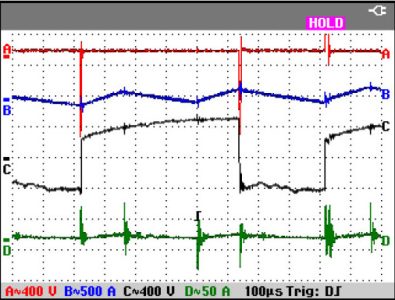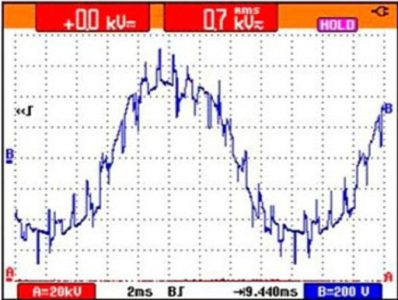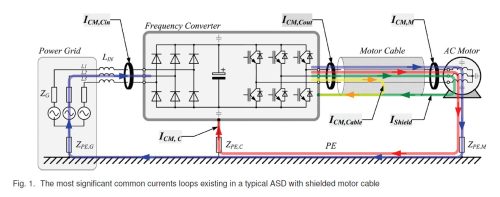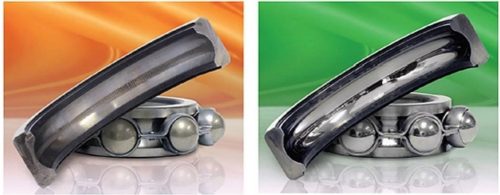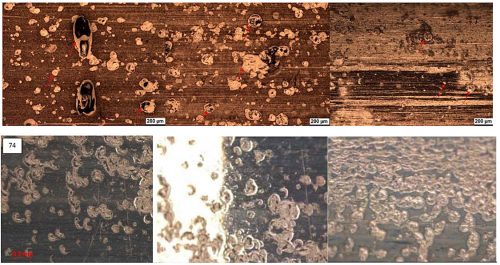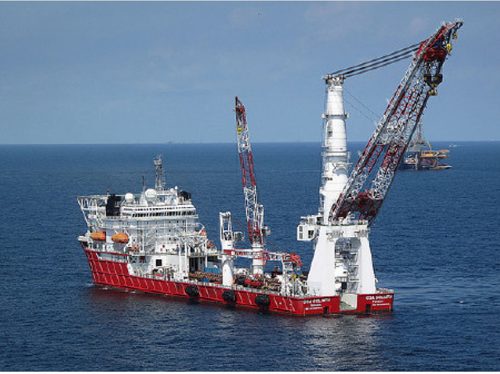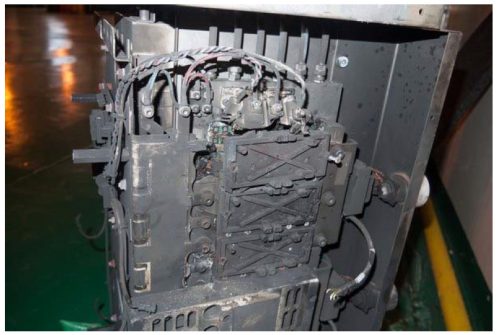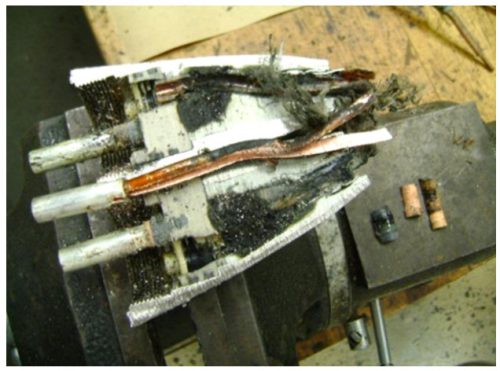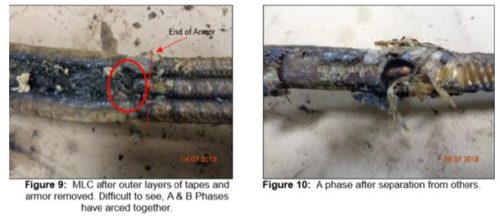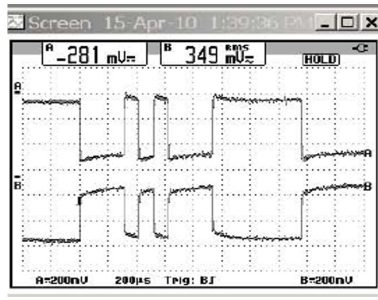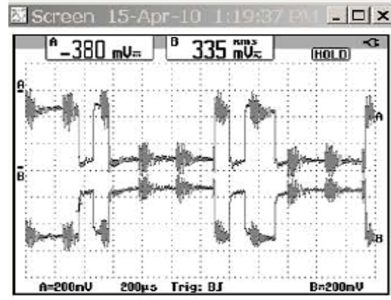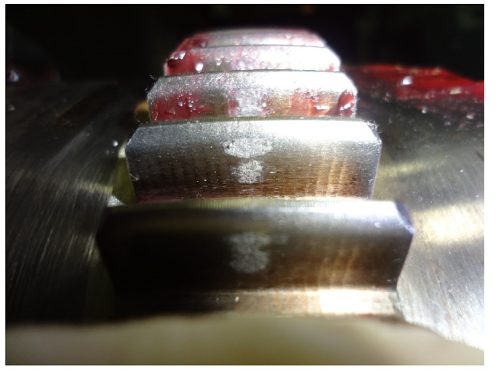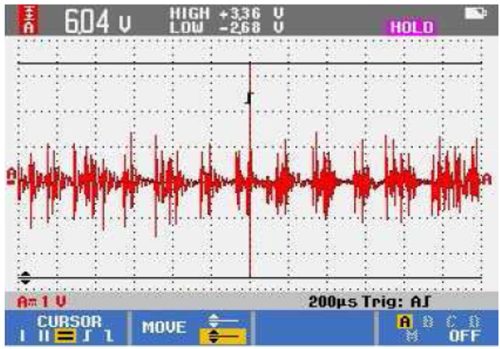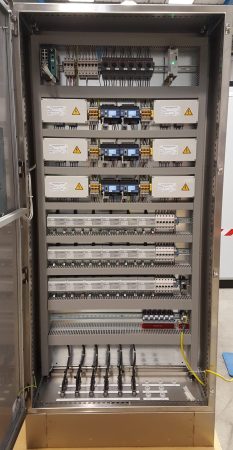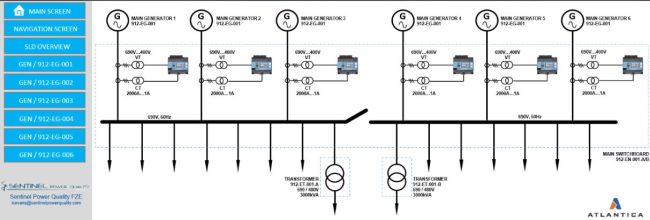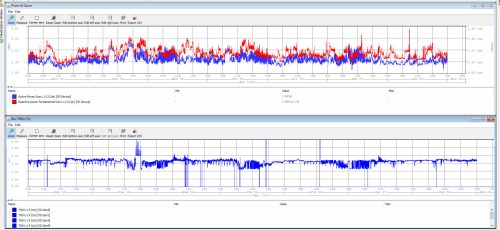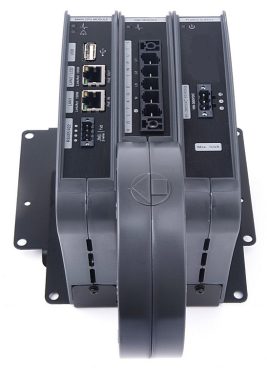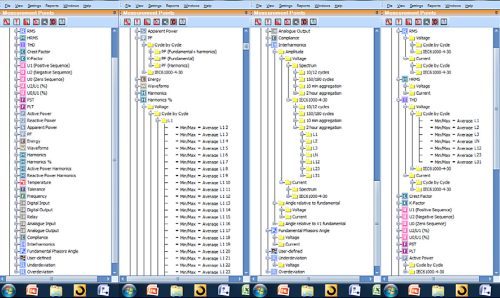Introduction
In the context of oilfield electrification, power quality is extremely important due of the increasing complexity, size and interconnection of electrical networks which oilfields and landrigs and their non-linear drive loads are/will be connected to. In addition, it gives crucial information on the connected loads (ESP, sucker rod pumps, landrigs et al), including prior warning of harmonics and PQ problems such as the impending failure of diode in one phase of large 6 pulse VFD as shown below.
In order to connect to utilities, legal contracts must be signed with the consumer which requires compliance with local PQ rules and international standards, for example the current IEEE 519. The salient PQ requirements include THDu, THDi and DFP (displacement power factor – not PQ). However, the utility has also a responsibility to oilfield consumers to provide an acceptable level of PQ, usually under, EN60150, “EU Product Standard for Voltage Supplied by Public Utilities”.
It must be stated that continuous PQ monitoring is essential to monitor the utility supply to the consumer AND to ensure compliance with their rules and regulations, which if non-compliant can result in penalties and/or disconnection. The data captured is crucial in the event is disputes with the utility. Any disturbances from the utility can have a serious impact on the oilfield equipment, downtime and associated costs.
See end of section for more information on continuous PQ monitoring….
Example of site PQ issue – DC drives
The first example comes from a landrig in Indonesia. The THDu exceeded 23.3% on occasion with significant high frequency voltage components.
The voltage notching harmonic spectra was due the lack of AC line reactors which is a clear and present danger should active filters be applied without special techniques, as they destroy the filter’s L-C-L passive filter.
The 560kW top drive VFD was not connected to the drilling supply but instead had its own generator. Due to incorrect installation of the VFD and motor from an EMC and grounding perspective, the common mode voltage travelled 182m though the ground to the landrig.
Example of site PQ issue – Jack-up drilling rig with VFDs
A new jack-up drilling rig with ~9,000kW of VFDs had experience problems due to the installation of over 2000A of active filters to mitigate the VFD drilling package. Initial problems were the failure of VFD snubbers. This delayed drilling. Once repaired, drilling resumed but 2 weeks later, one filter caught fire a seen below which stopped drilling yet again.
Once the destroyed filter was replaced, Harmonic Solutions Oil & Gas (HSOG) was tasked with testing all six filters to ensure correct operation. Each filter tested out OK. However, in each of the six tests, a 1.26kHz common mode voltage was present as can be seen before.
Due to the expensive problems directly attributed directly to the active filters, the IOC (international oil company) asked if their client could operate without them and still comply with ABS rules. HSOG simulated the drilling package harmonics and agreed that, on paper at least, was possible but must be verified by test. Cycle by cycle measurements were carried out over 11 days, including at maximum loading. The results are shown below in min/max and average as shown below. Since ABS MODU rules (8% THDu max with any single voltage harmonic <5%) is based on average values, the rig without active filters was fully compliant.
It was decided by HSOG to investigation the peak 10.58% THDu. The results can be seen in the following three trend illustrations.
The 180Hz CMV was due to generator dissimilar pitch problem when generators are paralleled and was relatively benign. The 1.26kHz voltage was due to the VFD drilling package switching frequency and was deemed problematic on a rig wide control and monitoring perspective and possibly a safety risk regarding the VFD fed Exe (increased safety) drilling package explosion proof motors !
Note : The above example demonstrates that HSOG advanced software permits can go from 24hrs per division to less than 20 milli-secs via a mouse, without any degradation of data.
Without this type of cycle-by-cycle PQ recorder and deep analysis software, many problems, including those pertaining to safety, would go unseen but their effects would not !
EMC & EMI
Note that “Power Quality” is mainly associated with ‘voltage quality’ and related issues. Any concerns or problems between, for example, the VFD output to a motor, can be classed as EMC/EMI. These can be associated with excessive du/dt, common mode voltage and current and cable resonance (‘standing waves’).
CMV is not harmonics but an EMC (electromagnetic compatibility) issue. It is measured between each phase and ground. One of the main producers of CMV are VFDs (variable frequency drives) and at relatively high power (for EMI).
Excessive common mode voltage can adversely affect susceptible and sensitive control and monitoring equipment and including other VFDs The associated common mode current is renowned for destroying motor bearings via high frequency micro-arcs of current.
Excessive THDu (total harmonic voltage distortion) is a serious issue on marine vessels, drilling rigs and platforms but is relatively easily resolved. However, “common mode voltage” (CMV) is of significantly more concern and challenging.
If, for example, a VFD and motor is not installed correctly from an EMC perspective (extremely common), the switching frequency of the VFD IBGT inverter bridge is superimposed on the phase to ground voltages.
Examples of typical problems due to common mode voltage
Common mode voltage example No 1– Bearing damage
The other serious aspect of CMV is the common mode current (CMC) which often accompanies CMV. The CMC, as it travels to ground via the motor bearings, subjects them to EDM (electro-discharge machining) via micro-arcs of current at the VFD switching frequency. Using insulated bearings simply move the problem to the bearings of the load (e.g. pump, fan et al). See below :
However, it is not only fed VFD motors which are at risk of bearing damage to CMV. Below are examples of fixed speed MV, >1000kW, EExd (flameproof) motors where the bearings are lasting no more than 1200-1400hrs.
This is occurring in the Zone 1 hazardous area of a large number of LNG gas carriers who all suffered from same bearing problems! The source of the CMV/CMC is the 45MW of PWM main propulsion drives installed on the vessels.
Common mode voltage example No 2 – Thruster VFD catastrophic failure
Below is a photograph of a thruster VFD IGBT (3000kW) which failed repeatedly due to common mode voltage on a crane vessel. (See below).
The common mode voltage interfered with the firing of the IGBTs (insulated gate bi-polar transistor switches) which resulted in two phase devices being triggered simultaneously, thereby causing a short circuit, the result of which can be see below :
Her sister ship suffered repeated thruster motor failures due to excessive du/dt (i.e. rate of rise of voltage) from her VFDs.
Common mode voltage example No 3 – Downhole ESP cable/connector damage
This example is from an offshore oil production platform in South-East Asia. The connectors and cables from fourteen ESP (electrical submersible pumps), driven VFDs (variable frequency drives). The ESP motors were also damaged, windings and bearings, due to common voltage and chemical reaction.
Common mode voltage example No 4 – Platform fire and gas detection system
This example illustrates the effects of common mode voltage on the operation of a jack-up fire and gas detection system. The top trace below illustrates the control pulses when the system operated normally. The bottom trace illustrates the result when a new 1200HP/900kW VFD was connected to the system.
When the cement pump was operating (lower trace) the fire and gas detection system faulted continuously, resulting in spurious gas alarms and was disabled until the cause of the failures were established and the system made fully operational again. This left the platform and personnel at risk for some days until the problem was resolved.
Common mode voltage example No 6 – Shaft generator coupling
The photograph below illustrates the effect of excessive common mode voltage through electrostatic discharges (ESD) on a 2500kW shaft generator with VFD voltage controller. The cause of the damage to the flexible coupling and bearings was incorrect EMC installation procedures (e.g. no special VFD rated cables from the VFD to the switchboard, incorrect glanding of cable shields and excessively long ground pigtails).
Pitting on the flexible coupling of a 2500kW shaft generator due to common mode voltage can be seen above. The final illustration above illustrates the voltage measured across the shaft of the generator.
Pitting on the flexible coupling of a 2500kW shaft generator due to common mode voltage can be seen above. The final illustration above illustrates the voltage measured across the shaft of the generator.
Common mode voltage example No 7 – Equipment power supplies
One aspect of excessive common mode voltage is that it can be very disruptive and damaging to sensitive and susceptible equipment connected to the same ground (also the hull); that includes control, measurement and communication equipment, plcs, monitoring equipment, computers, navigation equipment et al.
See below for an example of a PQ recorder damaged by excessive CMV from a poorly installed 630kW AFE (active front end) VFD.
Harmonic Solutions Oil & Gas offers a range of PQ and EMI site troubleshooting and consulting services :
- PQ investigations into oilfield/offshore equipment malfunction/failure
- Diagnosis and monitoring of common mode voltage and current (due to VFDs) and other EMC issues
- Studies (including harmonic modelling) on harmonics and related topics for offshore and oilfield power systems
- Consultancy into all aspects of offshore and oilfield PQ
- Pre-purchase PQ and EMI site measurements to ensure proposed mitigation equipment is correct and there are no issues and to identify that there are no hidden issues which could adversely affect the equipment performance and reliability. Note, this service is also available when considering equipment from other manufacturers.
To contact us for our offshore and oilfield PQ and EMI site services click here :
Continuous power quality monitoring
Harmonic Solutions Oil & Gas can provide continuous conventional and advanced cycle by cycle PQ monitoring.
Harmonic Solutions Oil & Gas can offer the PQGuard 4430 advanced ‘cycle by cycle’ power quality recorder which, when combined with dedicated power quality analytic software, provides unarguably the world’s finest harmonics, power quality and events monitoring system. The PQ recorder can accommodate current signals up to 5A per phase from conventional current transformer or via flexible Rogowski coils.
Every single cycle of voltage and current are recorded plus almost 5,000 power and PQ parameters. Harmonic voltages to the 512th and harmonic currents up to the 256th are captured. No event is missed. The example illustrated below shows an event on an offshore platform.
Features of PQGuard 4430 include :
- Sampling : 1024 samples/cycle
- Automatically capture evert cycle and over 5000 power and PQ parameters
- Harmonics & Interharmonics : Up to 511th voltage/256th current
- Internal memory : 16GB
- Transient detection : 19.5/16.3μs (50Hz/60Hz)
- Ethernet ports : 2
- Digital I/O : 8 in, 4 out
- Ride through power loss : Up to 25 secs
- Voltage channels : 4 off plus ground, 1000V rms continuously (8kV peak)
- Current channels : Up to 5 off, up to 5A (50A peak)
- Fundamental frequency : 42.5Hz to 69Hz
- Power supply : 110-260VAC and 100-300VDC, 48 VDC auxiliary
- Power over the Ethernet
- Built-in web server
- Operational ambient : -20 deg to 70 deg C
Note : Measurements from the G4400 (fixed version) and G4500 (portable version) illustrate the advanced analysis and troubleshooting possible with type of PQ monitoring devices.
Samples of typical parameter trees, using InvestigatorTM software is shown.
Contract PQ Monitoring
Whatever the type of PQGuard system you wish installed, Harmonic Solutions Oil & Gas can offer remote contract PQ monitoring. Let us take the full technical responsibility from your company by continuously monitoring, analysing and reporting on your installation’s harmonics and power quality, whether on a MODU, FPSO or land-based oilfield.
This service can also entail detailed annual PQ audits, if applicable, including the systems downstream where the normal continuous PQ monitoring does not apply.
Training can also be provided to local staff.
For more information contact us….

